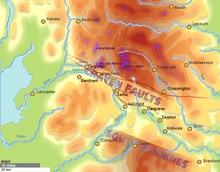Aire Gap
Aire Gap
 | |
|---|---|
| Location | Craven District, North Yorkshire, United Kingdom |
| Floor elevation | 179 metres (587 ft) |
| Long-axis direction | 128 degrees |
| Long-axis length | approx 40 kilometres (25 mi) |
| Width | approx 20 kilometres (12 mi) |
| Depth | average 300 metres (980 ft) |
| Geology | |
| Type | Glacial U-shaped |
| Age | Carboniferous through Pleistocene |
| Geography | |
| Bounded by | Craven Fault and north edge of South Pennines |
| Coordinates | 54°0′0″N 2°10′0″W / 54.00000°N 2.16667°WCoordinates: 54°0′0″N 2°10′0″W / 54.00000°N 2.16667°W |
| Population centers | (Settle), Hellifield, Gargrave, (Colne), Skipton, Sutton-in-Craven, Keighley |
| Traversed by | A65 road, "Little" North Western Railway, Leeds and Liverpool Canal |
Aire Gap is a pass through the backbone of England formed by geologic faults and carved out by glaciers. The term is used to describe a geological division, a travel route, or a location that is an entry into the Aire river valley.
Geology
Geologically the Aire Gap lies between the Craven Fault and the limestone uplands of the Yorkshire Dales to the north and the Forest of Bowland and the millstone grit moors of the South Pennines.[1] The South Pennines is the system between the Aire Gap and the Peak District.[2] The gap was formed by the dropping of the Craven Faults in the Carboniferous through Jurassic periods combined with glacial scouring by ice sheets in the Pleistocene Ice Age. The Aire Gap splits the Pennines into north and south by allying with the River Ribble. The Pennine chain is divided into two sections by the Aire Gap formed by the River Aire flowing south, a member of the Humber basin, and the Ribble flowing west and entering the Irish sea.[2]
Geography
The term Aire Gap is used in both Ribblesdale and Pendle to denote a hypsograph between those rivers and Airedale. Two locations are so described:
- Ribblesdale’s Aire Gap designates a precise point at 160 m (525 ft)[3] just East of Hellifield near Settle at 54°00′00″N 2°10′00″W / 54.00000°N 2.16667°W, and is labelled Aire Gap on some maps.[4] It is the watershed of that pass and lies between the "Little" North Western Railway and the A65 road.
- The head of Pendle Water valley culminates in Foulridge 53°52′36″N 2°10′35″W / 53.8768°N 2.176420°W near Colne. In literature Colne commonly describes itself as being in the Aire Gap. When the Leeds and Liverpool Canal was being constructed they dug a tunnel at altitude 140 m (459 ft) beneath Foulridge’s 165 m (541 ft) to make a route even lower than the 160m pass near Hellifield.
Transport route

The Pennines form a natural barrier to east-west communications, but the Tyne Gap links Carlisle and Newcastle and the Aire Gap links Lancashire and Yorkshire.[5]
To walk the Pennine moors is "potentially dangerous if the weather is bad and you are ill equipped. If the cloud comes down you will need both a compass and a knowledge of how to use it."— Jim Jarratt, 2006[6]
Its extent is vague, a 19th-century author wrote:
"This depression is known as the Aire Gap, occasionally as the Skipton Gap, Skipton being at its eastern end and Hellifield at its western end",
The Aire Gap is of considerable strategic importance and historically Skipton Castle controlled the area.[8] Skipton is now considered more central to the Aire Gap than terminal.
Topography

The treeless moorland gives no shelter and modern Pennine transport can find it a formidable barrier when roads are blocked by snow for several days. The Aire Gap route is a sheltered passageway, and inhabited along its length. The Aire Gap was of topographic significance for the historic North of England providing a low-altitude pass through "the backbone of England". It was the Pennine transport corridor from Cumbria and Strathclyde to the Vale of York. Neolithic long-distance trade is proved by many finds of stone axes from central Cumbria.
To the north stand limestone hills of up to 736 m (2,415 ft) above mean sea level and to its south lie bleak sandstone moors, that above 275 m (902 ft) grow little but bracken.[9]
The builders of the "Little" North Western Railway sought the lowest course through the Aire Gap and found that to be 166 m (545 ft) near Giggleswick scar at 54°04′27″N 2°19′05″W / 54.074167°N 2.318056°W, and 160 m (525 ft) just East of Hellifield at 54°00′00″N 2°10′00″W / 54.00000°N 2.16667°W a point labelled Aire Gap on maps.[4]
There is a lower pass from Airedale to Ribblesdale near Thornton-in-Craven of 144 m (472 ft) at 53°56′03″N 2°09′46″W / 53.93413°N 2.16276°W that was used by the Romans who built a road.
The nearest alternative pass is Stainmore Gap (Eden-Tees)[10] to the north that climbs to 409 m (1,342 ft) and its climate is classed as sub-arctic in places.[11]
References
- ↑ The Yorkshire Dales website. Retrieved 24 July 2011.
- 1 2 Encyclopædia Britannica
- ↑ Google Earth
- 1 2 Enter "Aire Gap, United Kingdom" on Bing Maps
- ↑ The Met office
- ↑ "The Watersheds Walk" by Jim Jarratt. Retrieved September 2010.
- ↑ T. D. Whitaker, Vicar of Whalley. The History and Antiquities of the Deanery of Craven, 1878. Republished 1973 by E. J. Morten and the Craven Herald, ISBN 978-0-901598-71-4
- ↑ The Yorkshire Dales website
- ↑ page 4 and page 5, Marginal Upland Grazing Sutton Moor, Domesday Reloaded, BBC 1986
- ↑ Shop for OS Maps, Create & Share Routes with getamap | Ordnance Survey Leisure Ordnance Survey Explorer Map, OL41, Forest of Bowland and Ribblesdale ISBN 978-0-319-24071-7
- ↑ "Regional mapped climate averages". The Met Office.